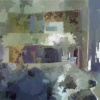Bio
Ben Bogart is a generative artist primarily working in installation and print whose practice is located at the intersection of art and science. His installations create
content live in response to their sensed environment. Physical modelling, chaos, feedback systems, evolutionary algorithms, computer vision, and machine learning
have been used to inform and engage in his creative process. Ben holds a Ph.D. in Interactive Arts and Technology from Simon Fraser University. In his Ph.D.
research, he proposes an Integrative Theory of cognitive and neurobiological mechanisms of perception, mental imagery, mind-wandering, and dreaming. This
cognitive framework is manifest in a computational model and site-specific generative art installation: Dreaming Machine #3.
Artist’s Statement
If we consider artistic practice as a continuum between exploration and expression, my work emphatically emphasizes the former. I see art production as a
methodology for making propositions and asking questions concerning how we see, represent, and understand the world and ourselves. These propositions and
questions are manifest in cultural objects (artworks) that are produced at the intersection of cultural, technical, and scientific knowledge. This reflection of cultural and
scientific knowledge is a central theme of my practice.
Knowledge is constructed and shared through culture and is manifest in representations. Many of these representations are visual and attempt to make visible that
which cannot be seen directly. Both arts and sciences involve the construction of representations meant to generate and present knowledge about ourselves and the
world.
My interest in art as exploration led me to the interactive and electronic media installations and improvised visual performances my production favoured between
1999 and 2005. The inclusion of the viewer’s behaviour in the work was an effort to explore the autonomy of computational systems through eliciting the participation
of the viewer. While my interest in interactive art has waned, my interest in the autonomy of our technical artifacts has remained. Rather than inviting the viewer to
participate in an interactive process, my recent practice involves the integration of knowledge from artificial intelligence, neuroscience, psychology, and cognitive
science, all of which involve an enquiry of mind and the autonomy of life.
Since 2006 I have focused my work on a series of Context Machines, a set of site-specific generative and computational artworks that use cameras to collect images
of their environment to be used as material in their processes of image-making. These processes exploit machine learning algorithms that attempt to find the structure
of the world and reflect it in their visual representations of the environment. A spin-off of theContext Machines are the Self-Organized Landscapes. This is a series of
large scale print collages composed of thousands to tens of thousands of individual images that are collected at a particular site and arranged according to their visual
similarity.
The Context Machines series continues in my Ph.D. project, Dreaming Machine #3, in which image-making processes are explicit manifestations of cognitive and
neurological theories of perception, dreaming, and mind-wandering.

Comments are closed